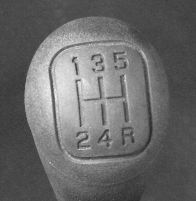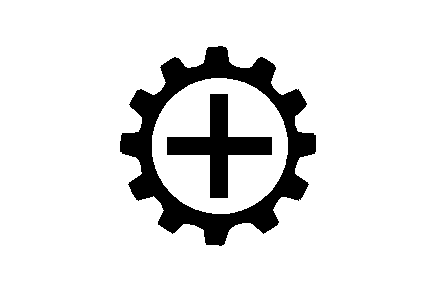Five-Speed (VORTEC 6.0L V8 Engine)

Here is how to operate your transmission.
FIRST (1) is intended only for heavy loads or trailer towing and is not recommended for normal driving.
During the first 500 miles (805 km) of vehicle use, start your vehicle moving in FIRST (1). This allows clutch components to break-in properly.
FIRST (1): Press the clutch pedal and shift into FIRST (1). Then, slowly let up on the clutch pedal as you press the accelerator pedal. Shift into FIRST (1) only when the vehicle is below 5 mph (8 km/h).Notice: If you try to shift down into FIRST (1) at excessive vehicle speeds, clutch or engine damage could occur. Do not shift into FIRST (1) unless you are going less than 5 mph (8km/h).
SECOND (2): Press the clutch pedal and shift into SECOND (2). Then, slowly let up on the clutch pedal as you press the accelerator pedal. You can shift into SECOND (2) when you are going less than 20 mph (32 km/h). If you have come to a complete stop and it is hard to shift into SECOND (2), put the shift lever into NEUTRAL and let up on the clutch. Press the clutch pedal back down. Then shift into SECOND (2).Notice: If you try to shift down into SECOND (2) at excessive vehicle speeds, clutch or engine damage could occur. Do not shift into SECOND (2) unless you are going less than 20 mph (32km/h).
THIRD (3): Press the clutch pedal and shift into THIRD (3). Then, slowly let up on the clutch pedal as you press the accelerator pedal.FOURTH (4) and FIFTH (5): Shift into the higher forward gears the same way you do for THIRD (3). Slowly let up on the clutch pedal as you press the accelerator pedal. To stop, let up on the accelerator pedal and press the brake pedal. Just before the vehicle stops, press the clutch pedal and the brake pedal, and shift to NEUTRAL.
NEUTRAL: Use this position when you start or idle your engine.
REVERSE (R): To back up, first press down the clutch pedal. Wait for the vehicle to stop moving and then, shift into REVERSE (R). Let up on the clutch pedal slowly while pressing the accelerator pedal.
Notice: Shifting to REVERSE (R) while your vehicle is moving forward could damage the transmission. The repairs would not be covered by your warranty. Shift to REVERSE (R) only after your vehicle is stopped.
Also, use REVERSE (R), along with the parking brake, when turning off your engine and parking your vehicle.
Five-Speed (VORTEC 4.3L V6 and 4.8L V8 Engines)
Here is how to operate your transmission:
FIRST (1): Press the clutch pedal and shift into FIRST (1). Then, slowly let up on the clutch pedal as you press the accelerator pedal. You can shift into FIRST (1) when you are going less than 20 mph (32 km/h). If you have come to a complete stop and it is hard to shift into FIRST (1), put the shift lever into NEUTRAL and let up on the clutch. Press the clutch pedal back down. Then shift into FIRST (1).Notice: If you try to shift down into FIRST (1) at excessive vehicle speeds, clutch or engine damage could occur. Do not shift into FIRST (1) unless you are going less than 20 mph (32km/h).
SECOND (2): Press the clutch pedal as you let up on the accelerator pedal and shift into SECOND (2). Then, slowly let up on the clutch pedal as you press the accelerator pedal.THIRD (3), FOURTH (4) and FIFTH (5): Shift into THIRD (3), FOURTH (4) and FIFTH (5) the same way you do for SECOND (2). Slowly let up on the clutch pedal as you press the accelerator pedal. To stop, let up on the accelerator pedal and press the brake pedal. Just before the vehicle stops, press the clutch pedal and the brake pedal, and shift to NEUTRAL.
NEUTRAL: Use this position when you start or idle your engine.
REVERSE (R): To back up, first press down the clutch pedal. Wait for the vehicle to stop moving and then, shift into REVERSE (R). Let up on the clutch pedal slowly while pressing the accelerator pedal.
Notice: Shifting to REVERSE (R) while your vehicle is moving forward could damage the transmission. The repairs would not be covered by your warranty. Shift to REVERSE (R) only after your vehicle is stopped.
Also, use REVERSE (R), along with the parking brake, when turning off your engine and parking your vehicle.
Shift Speeds
Caution: If you skip a gear when you downshift, you could lose control of the vehicle. You could injure yourself or others. Do not shift down more than one gear at a time when you downshift.
Do not allow the engine Revolutions Per Minute (RPM) to overspeed and enter the tachometer red lines. Engine overspeed occurs when downshifting, or descending a grade, at too high a vehicle speed. When going down steep grades, always select a gear at least one position lower than you would use on climbing a grade. This will allow the vehicle's engine to provide some braking and help to slow the vehicle as it goes down the grade. Monitor your vehicle speed, acceleration and engine RPM while applying the brakes as you go down the grade to ensure you have complete control over the vehicle.
If your engine speed drops below 600 rpm, or if the engine is not running smoothly, you should downshift to the next lower gear. When operating on slippery surfaces, downshift at lower than normal vehicle speeds to prevent the tires from slipping.
In vehicles that have a bench seat, move the tallest beverage containers to the right cupholder to provide additional clearance for the shift lever.
For vehicles that have a center console, the front cup holder pulls out and turns 180° to provide additional clearance between tall beverage containers and the shift lever.
Up-Shift Light

If your vehicle has a manual transmission, you may have a shift light. This light will show you when to shift to the next higher gear for best fuel economy.
When this light comes on, you can shift to the next higher gear if weather, road and traffic conditions allow. For the best fuel economy, accelerate slowly and shift when the light comes on.
While you accelerate, it is normal for the light to go on and off if you quickly change the position of the accelerator.
If your vehicle has four-wheel drive and has a manual transmission, disregard the shift light when the transfer case is in Four-Wheel Low.
Ignore the shift light when you downshift.
